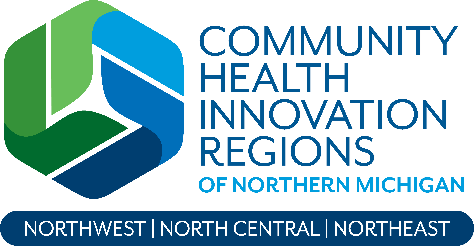MDHHS defines a CHIR as a “unique, coordinated approach to improving conditions where people live, work, learn, and play by bringing together a broad group of individuals to improve wellbeing of residents by addressing factors that affect people’s health.”
Of the five Community Health Innovation Regions (CHIRs) designated by Michigan Department of Health and Human Services (MDHHS) in 2016 for its federal State Innovation Model Grant, the Northern Michigan CHIR is the only one that serves a rural area. Initially it was defined as the 10 counties in Northwest Michigan and over time, funding was secured to launch the Northeast and North Central CHIRs. It is also the only CHIR that serves a large region or has a backbone organization from public health.
The backbone organization is the Northern Michigan Public Health Alliance, a partnership of seven local health departments that serve the 31-county CHIR region. The “innovation” in the Northern Michigan Community Health Innovation Region is a public approach: integrating strategies at individual, sector, and system level to reduce barriers to social drivers of health. Evaluation studies in the Northwest CHIR documented significant outcomes:
- Effective collaboration according to the Northern Michigan CHIR Collective Impact Evaluation by Michigan State University in 2019Unprecedented levels of cross-sector collaboration and increased recognition among local leaders of the role of social determinants in influencing health and other outcomes, :
- Coordinated system: Transformation of individual lives and creation of a more responsive and effective organizations and a more accessible, coordinated service system, according to the Northern Michigan CHIR Collective Impact Evaluation by Michigan State University in 2019.
- Cost savings: $3M in savings to Medicaid Health Plans in first five years of Community Health Worker (CHW) navigation services, according to an analysis completed by MDHHS in 2021
- Expense reduction: $1.21 in averted medical costs for every $1 of CHW navigation services provided, according to a cost benefit analysis conducted by the Michigan Public Health Institute in 2022
- Increased self-efficacy: 80% of clients from CHW navigation services report they are able to help themselves in the future, according to a customer satisfaction survey completed by University of Michigan in 2019
- Strong return on investment: Partnerships have provided over $5M in additional funding through federal, state, and local grants; contracts with Medicaid Health Plans; financial contributions from hospitals; and a matching mechanism available to local health departments for eligible activities.
The three CHIRs share a framework that consists of shared vision and mission, backbone organization, and regional administration of two primary service lines:
To resolve individual and family needs for social needs, the CHIR operates the Community Connections Network. Certified by the Pathways Community HUB Institute, the network is composed of six hubs, each operated by a different local health department. They share policies and procedures, staffing model and training, electronic health record, and Pathways. Pathways are lists of evidence-based steps for a specific social need like housing, food security, or utilities assistance. CHWs assist clients in completing these steps and cannot close the Pathway until all have been completed. For example, for the Behavioral Health Pathway, the client must make and keep three appointments with a provider because research shows they are likely to continue treatment.
MiThrive is the CHIR’s community health needs assessment and improvement initiative. It carefully monitors Community Connections client data regarding the number and types of Pathways opened and closed across the region. MiThrive Workgroups, one in each CHIR, pay close attention to the Pathways that cannot be closed because they highlight barriers clients are experiencing. Every three years, the CHIR convenes hospital systems, local health departments, and other community partners to complete a common, community health needs assessment, review data, prioritize issues for action, and co-develop community health improvement plans with residents and partners. MiThrive is one of five communities in the country selected to pilot the National Association of City and County Health Officials’ community health improvement and assessment guidance and adapt it for use in rural areas.
Detailed data from both Community Connections and MiThrive is posted on the CHIR’s website. Making data accessible is one of the CHIR’s key goals. Partners use it for their own strategic planning, talking points with policymakers, and grant writing.
While the three CHIRs share a common framework, they can also launch initiatives to meet particular needs in their regions. For example, the Northwest CHIR has initiatives to increase access to behavioral health services and increase health equity and the North Central CHIR is implementing an initiative to reduce chronic disease.
